2016 Vegetable Variety Trials
Seed breeders are working to bring you varieties with the qualities you need to produce a great crop that consumers will want to buy.
After a recent trip to fields in California and Ohio to visit with representatives from Syngenta, Sakata Seed America, and Rupp Seeds, American Vegetable Grower® magazine learned about several new varieties that offer long shelflife, great taste, and the ability to withstand disease pressure. Check ’em out!
SYNGENTA, WOODLAND, CA
‘Astound’ and ‘Accolade’
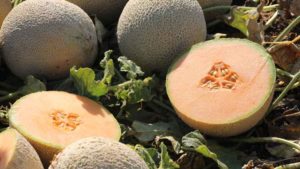
Gold Crown
New Eastern shipper melons — ‘Astound’ and ‘Accolade’ — feature firm flesh, extended shelflife, and good holding ability in the field. According to Bert Stoddard, Cucurbits Product Lead at Syngenta, both also feature a strong disease resistance package, including resistance to Fusarium wilt races 0, 1, and 2, and powdery mildew races 1 and 2.
‘Gold Crown’
‘Gold Crown’ is Syngenta’s new Western shipper melon with high resistance to Fusarium wilt races 0 and 2, and intermediate resistance to powdery mildew. This variety, which is slightly larger than ‘Gold Express,’ is tolerant to sulfur and features an oval shape with a well-netted exterior. Stoddard says it is suited to California’s San Joaquin Valley and matures in 85 days.
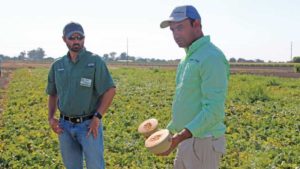
Describing MS4186, a melon variety in its trial phase, are Syngenta’s Bert Stoddard (left) and bre.eder Rakesh Kumar. This variety is slated for commercial production in late 2017
MS3303, MS4186, MS4313, and MS4344
These four varieties are in the trial phase. A new Harper type, MS3303 is a good performer. In its first year of trials, it has shown good disease resistance to Fusarium wilt races 0, 1, and 2, powdery mildew and cotton aphid, and it has sulfur tolerance, Stoddard says.
MS4186 and MS4344, slated for introduction in late 2017, also show promise. These Harper types have resistance to Fusarium wilt and powdery mildew.
MS4313 is part of Syngenta’s global program and has good field-holding capabilities and boasts a high level of sugar.
‘Sweet Dawn’
In the watermelon department, ‘Sweet Dawn’ was released for sales this past season. It has a classic rind and is a 36- to 45-count fruit, but can have a few 60 count. It has intermediate resistance to Fusarium wilt race 1 and Anthracnose race 1.
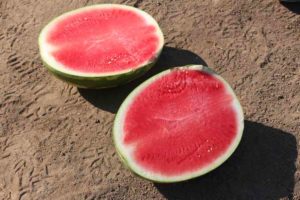
‘Sweet Dawn’ was released for sale this past season and matures in 74 days.
It matures in 74 days, which is about a week before ‘Fascination,’ says Chris Hahn, a Syngenta Watermelon Breeder.
‘Excursion’
‘Excursion,’ formerly WDL2413, is being introduced this season. This variety can be harvested one to two days earlier than ‘Fascination,’ maturing in about 81 days. It weighs between 17 and
22 pounds and has intermediate resistance to Fusarium wilt race 1 and Anthracnose race 1.
Syngenta is also working on varieties that will be resistant to Fusarium wilt race 2, which has been a major problem for growers recently. The challenge, Hahn says, is developing a variety that performs well and also has resistance to race 2.
“We are doing wider trials of race 2 experimental varieties in the East and the West
and we will continue to work on it as race 2 is an important trait in the watermelon breeding program,” Hahn says.

A new variety, ‘Excursion’ weighs between 17 and 22 pounds and can be harvested a couple days earlier than ‘Fascination.’
‘Grandprize’
A new squash variety on the horizon is ‘Grandprize’ (formerly SN0013). Syngenta
Squash Breeder Les Padley says the plan is to have the variety available in the fall 2017. ‘Grandprize’ is for East and West production and has resistance to zucchini yellow mosaic virus, watermelon mosaic virus, and powdery mildew. It is a creamy yellow straightneck that grows on an erect plant. “It looks beautiful from the day it is blooming to the day it is harvested,” Padley adds.
RPP705 and RPP867
Two newer bell pepper varieties include RPP705 and RPP867. RPP705 boasts a dark color and is slated for release next year. According to Gabriel Castaneda, Product Evaluating Officer for Peppers, RPP867 is a heavy pepper that is best suited for the processing market. Both varieties are resistant to tomato spotted wilt virus.
RFT712622 and RFT711734
Tomatoes also were part of the conversation. Two new varieties Sundrish Sharma, a Tomato Breeder at Syngenta, talked about were RFT712622 and RFT711734.
“We were looking at what we can bring that is different than our traditional hybrids

RFT711734, a tomato variety which is
currently being trialed, has tomato spotted
wilt and nematode resistance.
and the solution that we have identified that is under trialing is RFT712622,” Sharma explains. “It offers both yield and size uniformity and nice fruit set.”
He adds that in packout trials, RFT712622 is showing better performance than other commercial hybrids in the marketplace. Both RFT712662 and RFT711734 have tomato spotted wilt and nematode resistance.
SAKATA SEED AMERICA, SALINAS AND WOODLAND, CA
In Salinas, Sakata highlighted some new leafy vegetables as well as its latest broccoli variety.

‘Seaside’ is one of four new spinach varieties from Sakata that has resistance to downy mildew race 16.
‘Lakeside,’ ‘Oceanside,’ ‘Riverside,’ and ‘Seaside’
Spinach producers now have four new varieties — ‘Lakeside,’ ‘Ocean-side,’ ‘Riverside,’ and ‘Seaside’ — that are resistant to downy mildew race 16, which has been a big issue
for growers.
‘Lakeside’ features dark-green leaves and grows on an upright plant habit.
‘Oceanside’ features a thick leaf and grows at a slow to moderate pace.
‘Riverside’ has spade-shaped leaves and is said to be a good choice for West Coast baby leaf growers because the leaves are more upright, which makes them easier to harvest.
‘Seaside’ has round-to-oval, thick, dark-green leaves, and a moderate growth rate.
‘Miz America’
An upright hybrid, this uniform mustard is also making its debut in the market. A selling attribute of ‘Miz America’ is its versatility and the deep-red color on both sides of the leaves
doesn’t fade, says Delita Pardue, Production Manager.
‘Fire Fresh’ and ‘Ruby Fresh’
Swiss chard variety ‘Fire Fresh’ has bright red petioles and medium-dark-green leaves. It also has intermediate resistance to downy mildew and resistance to Cercospora leaf spot.
‘Ruby Fresh,’ also has red petioles and great veination. It is also said to be ideal for baby leaf or spring mix growers.
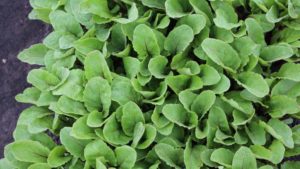
Sakata highlighted three baby leaf beets, ‘Fresh Cool,’ Fresh Pak,’ and ‘Fresh Start’ for spring mix growers. ‘Fresh Pak’ is a slow-to-moderate growing variety and Fresh Start is a fast growing baby leaf. Pictured here is‘Fresh Pak.’
‘Fresh Cool,’ ‘Fresh Pak,’ and ‘Fresh Start’
Three baby leaf beets, ‘Fresh Cool,’ ‘Fresh Pak,’ and ‘Fresh Start,’ also were highlighted. A slow-to-moderate-growing baby leaf variety, ‘Fresh Cool’ features dark-red petioles with dark-green leaves. ‘Fresh Pak’ grows slowly to moderately in mid-summer and has high resistance to beet downy mildew and intermediate resistance to Cercospora leaf spot. A faster growing variety, ‘Fresh Start,’ has a disease package that works for East and West growers.
‘Eastern Magic’
East Coast growers are looking for adaptability and heat tolerance with broccoli varieties, and Sakata has one to offer with ‘Eastern Magic.’ “It looks great in the heat,” says Lisa Ward, Assistant Broccoli, Cabbage and Chinese Cabbage Product Manager for the Northeast. “It is very adaptable for the Northeast and Mid-Atlantic and has a nice blue-green color and a great dome and shape.”
In Woodland, Sakata focused on cucurbits, tomatoes, peppers, and onions.
‘Little Dipper’
A new butternut squash, ‘Little Dipper’ is a high yielder that grows on a full vine. As its name implies, the personal size or mini squash weighs about 2 pounds.

A new personal-size butternut squash, ‘Little Dipper’ is a high yielder that grows on a full vine.
Featuring a bright-orange interior, this variety matures in 100 to 110 days.
‘Toad’
Also in the two-pound range, ‘Toad’ is a semi-hard shelled pumpkin with warts. Maturing in 80 days, it is noted as an early and unique product that is geared toward farm markets, according to Dennis Thome, Product Manager for Squash and Pumpkin.
XME 7153
XME 7153 is a long-shelflife melon that has high resistance to Fusarium wilt races 0, 1, and 2. This variety is smaller than ‘Infinite Gold.’
‘Grand Marshall’
‘Grand Marshall,’ formerly known as STM7262, is a new salad tomato that has high resistance to Alternaria stem canker, Fusarium wilt races 1 and 2, and intermediate resistance to gray leaf spot and tomato yellow leaf curl virus.
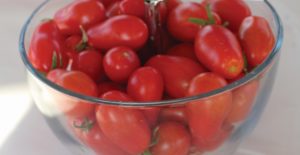
A determinate grape tomato, ‘Carmesin’ comes with a strong disease-resistance package.
‘Carmesin’
‘Carmesin,’ also known as STM2459, is a new determinate grape tomato. This variety comes with a strong disease-resistance package. According to Kimberly Kuden, the Tomato and Pepper West Coast Production Manager, the Brix levels on this variety change depending on the soil. Seed was made available last month.
‘Cherokee’
‘Cherokee’ is a new bell pepper noted for its size and quality. It has high resistance to pepper mottle virus races 1, 2, and 3; tobacco mosaic; bacterial spot races 0-3, 7, and 8; and intermediate resistance to tomato spotted wilt virus.
‘Orenji’
A new green-to-orange bell, ‘Orenji’ has high resistance to tobacco mosaic races 0-2 and intermediate resistance to tomato spotted wilt virus. It is said to be well suited to warm to cool production slots.

‘Yosemite’ has good pink root resistance and ranges in size from colossal to jumbo.
‘Yosemite’
The latest onion release is ‘Yosemite,’ which has good pink root resistance. Mike Hansen, Senior Product Development Manager for Onions, says what separates this variety from the competition is its several layers of vibrant skin, providing a long day look in an intermediate onion. ‘Yosemite’ ranges in size from colossal to jumbo.
RUPP SEEDS, WAUSEON, OH
‘Bayhorse Gold’
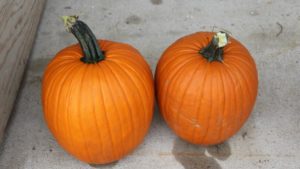
‘Bayhorse Gold’ has powdery mildew tolerance and weighs between 15 and 20 pounds.
A slightly elevated pumpkin with powdery mildew tolerance, ‘Bayhorse Gold’ weighs between 15 and 20 pounds and matures in 100 days. A Rupp-bred exclusive and proprietary variety, it features heavier ribs and a very dark-orange color, says Sheldon Sutton, Rupp Seeds’ Product Development Coordinator.
‘Eagle City Gold’
This pumpkin also matures in 100 days and has powdery mildew tolerance. It is usually slightly larger than ‘Bayhorse Gold,’ weighing between 18 and 24 pounds. ‘Eagle City Gold’ is medium-dark orange and has a slightly smoother texture than ‘Bayhorse Gold,’ which makes it easier to paint, Sutton says.
‘Skidoo Gold’
A new mid-sized pumpkin is ‘Skidoo Gold,’ a 90-day variety that weighs 12 to 15 pounds. Featuring a good handle, it has a blocky shape and powdery mildew tolerance. According to Sutton, ‘Skidoo Gold,’ which also is a Rupp-bred, exclusive, and proprietary variety, will replace a couple pumpkin varieties that are not powdery mildew tolerant in the 12- to 15-pound class.
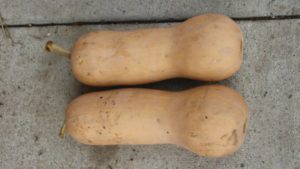
A Rupp-bred butternut squash, ‘Betternut 23’ is for both fresh market and processing.
‘Betternut 23’
‘Betternut 23,’ a Rupp-bred butternut squash, is a 105-day crop that serves a dual purpose: It can be used for fresh market or processing. “It is uniform from neck to bulb, which is something processors like to see,” Sutton says.
‘Bisbee Gold’
‘Bisbee Gold’ is a new pie pumpkin that weighs between 6 and 8 pounds. It is tolerant to powdery mildew and matures in 90 days. It is a deep-orange color, has deep ribs, and a dark handle.
‘Gizmo’
A gourd that hit the market last year is ‘Gizmo,’ which matures in 90 to 100 days. Used for decoration, this exclusive Rupp variety is larger than most other winged gourds, spanning 6 to 8 inches across.
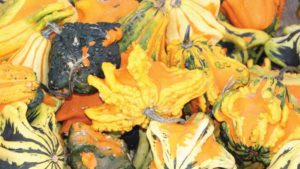
‘Gizmo’ is a decorative gourd that matures in 90 to 100 days and is larger than most winged gourds, spanning 6 to 8 inches across.
‘Blonde Beauty’
Another Rupp exclusive is ‘Blonde Beauty,’ a yellow summer straightneck squash that matures in 40 days. This spineless squash also is powdery mildew tolerant.
‘Hoargarth’
This round gourd had limited seed in 2015. A better seed supply will be available this year, Sutton says. Maturing in 90 days, ‘Hoargarth’ is bred by Rupp Seeds and is 5-by-7 inches wide.










